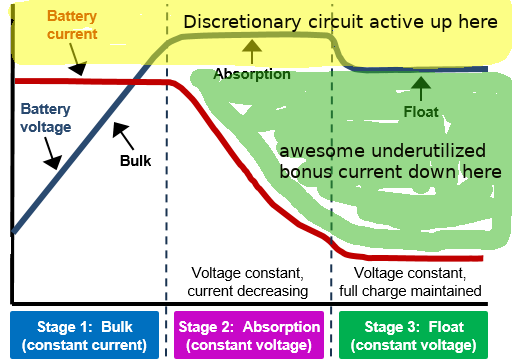frater secessus
Well-known member
Maybe everyone has already considered this and I am the last one to arrive at the party, but....
I've been thinking about how to maximize the usable capacity of small solar setups when folks are limited in physical space or funds. The MPPT controller is capturing a ton of power from the panels during Bulk but we are "wasting sunlight" in Acceptance and Float. What if we could shift some of the overall load to the Acceptance/Float stages to recapture some of that capacity?
Proposed method: power discretionary (non-essential or at least not time-sensitive) loads off the charge controller's LOAD output*, with the LOAD low voltage disconnect set to float voltage. Examples of discretionary loads: phone/tablet/laptop/drill charging, entertainment, etc.
Essential loads would come off the battery through a ~12.1v LVD setup as usual.
I drew on one of Chargetek's graphics:

I think this would:
I would like opinions on this. It would be really cheap to implement, particularly during the build. A few extra bus bars and at least one parallel run of wire to the far side of the camper.
* or a standalone LVD with a high setpoint, but I am having trouble finding those
I've been thinking about how to maximize the usable capacity of small solar setups when folks are limited in physical space or funds. The MPPT controller is capturing a ton of power from the panels during Bulk but we are "wasting sunlight" in Acceptance and Float. What if we could shift some of the overall load to the Acceptance/Float stages to recapture some of that capacity?
Proposed method: power discretionary (non-essential or at least not time-sensitive) loads off the charge controller's LOAD output*, with the LOAD low voltage disconnect set to float voltage. Examples of discretionary loads: phone/tablet/laptop/drill charging, entertainment, etc.
Essential loads would come off the battery through a ~12.1v LVD setup as usual.
I drew on one of Chargetek's graphics:
I think this would:
- energize the discretionary circuit only when the battery is charging, and likely in absorption or float since most systems spend the majority of their time there. Bonus: plenty of untapped current available in these phases.
- let normal, essential circuits cycle the bank down to 50% DoD.
- increase battery health by allowing a more rapid recharge in the morning; reduced load on the system until the system hits Vfloat. Reduces battery murder.
- reduce the time spent at 50% DoD; the bank hits 50% later at night due to reduced load. This also reduces battery murder.
- reduces human errors like "I'll turn off that load when the sun goes down"
- reduces the need to add more batteries, which also reduces the time spent at 50% DoD, saves money, weight and space
I would like opinions on this. It would be really cheap to implement, particularly during the build. A few extra bus bars and at least one parallel run of wire to the far side of the camper.
* or a standalone LVD with a high setpoint, but I am having trouble finding those




